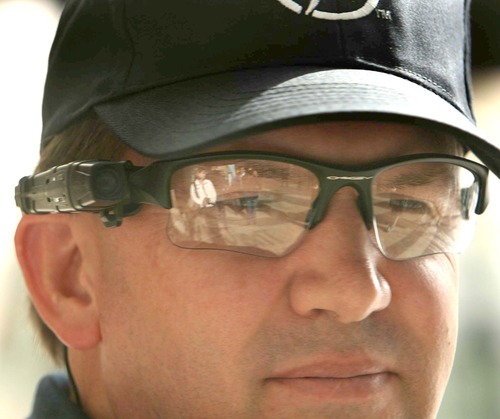This is an archived article that was published on sltrib.com in 2013, and information in the article may be outdated. It is provided only for personal research purposes and may not be reprinted.
Salt Lake City Police Chief Chris Burbank says that a number of his officers will soon be wearing body cameras that will record everything they see.
Burbank revealed this week at a Civilian Review Board meeting that the department is close to deploying 15 of the cameras. The SLCPD's camera of choice is the Taser AXON Flex on-officer system, a small, lightweight camera that an officer can clip to a headband, sunglasses or shirt collar.
SLCPD has finished testing the cameras and is drafting policies and procedures for them, such as when the cameras should be on, which videos to keep, how to store them and for how long, said Deputy Chief Jim Coleman. The department intends to ask for feedback on the drafted policies from the American Civil Liberties Union of Utah, defense attorneys, the Salt Lake County District Attorney's Office and the Civilian Review Board — which fields complaints against SLCPD and serves as liaison between it and the public.
Police media director Lara Jones said officers could be wearing the cameras within the next few weeks, a goal that is contingent upon dealing with some of the technical issues associated with the equipment, including the need for officers to download the footage to computers at the end of their shifts.
The camera footage can be used as evidence and help clear up complaints leveled against police by providing a picture of what happened. Attorneys would have access to the footage through a secure online database as well.
"It's a dramatic change in how we do business," Burbank said.
Ultimately, Burbank wants 300 of the cameras for his police force of about 450 men and women. But the next budget year looks tight, so he doesn't have high hopes for many more quite yet. They cost about $1,000 a piece, and then there is the expense of server space for storing the footage.
At the review board meeting, Burbank mentioned a California study that showed body cameras reduce both citizen complaints and officers' use of force. Though he could not recall the specific study, the Rialto (Calif.) Police Department saw an 88 percent decline in complaints during the year in which they were wearing cameras, compared with the year before when they were not, according to the International Herald Tribune. The Rialto police also used force 60 percent less that year than the year before.
It becomes a case of the police and the public watching each other, Burbank said.
"This can be a good thing," said ACLU of Utah Executive Director Karen McCreary, who looks forward to the evidence and transparency the videos could provide. But privacy is also a concern whenever it comes to collecting information on the public, such as how securely it is stored and who has access, and she looks forward to reviewing the proposed policies.
Burbank said the footage, which would be housed on a third-party company's servers, is likely to be kept and disposed of on a similar schedule as the rest of SLCPD's evidence. Only select people will have access to the videos and the power to delete them.
The chief said he is confident that the cameras are the future of the police force. The SLCPD has already stopped buying dashboard cameras for police cruisers and is redirecting those funds to body cameras.
The dashboard cameras are useful for traffic stops, Burbank said, but such stops comprise only a small portion of the interactions police have with the public.
Burbank said the SLCPD went with eye- and shoulder-level cameras as opposed to cameras that attach to the chest because, with those, the view can be obscured as soon as an officer holds up his or her gun.
Twitter: @mikeypanda





